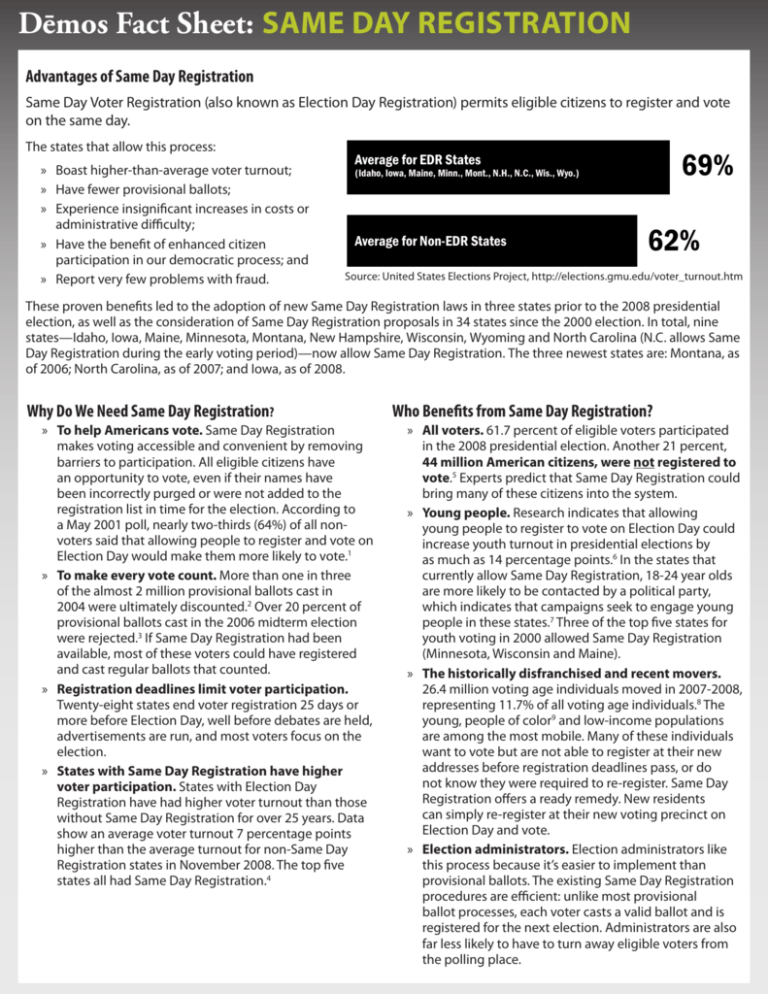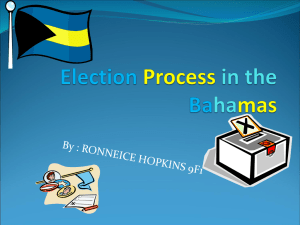SAME DAy REgiStRAtion
advertisement

Dēmos Fact Sheet: SAME Day Registration Advantages of Same Day Registration Same Day Voter Registration (also known as Election Day Registration) permits eligible citizens to register and vote on the same day. The states that allow this process: » Boast higher-than-average voter turnout; » Have fewer provisional ballots; » Experience insignificant increases in costs or administrative difficulty; » Have the benefit of enhanced citizen participation in our democratic process; and » Report very few problems with fraud. 69% Average for EDR States (Idaho, Iowa, Maine, Minn., Mont., N.H., N.C., Wis., Wyo.) Average for Non-EDR States 62% Source: United States Elections Project, http://elections.gmu.edu/voter_turnout.htm These proven benefits led to the adoption of new Same Day Registration laws in three states prior to the 2008 presidential election, as well as the consideration of Same Day Registration proposals in 34 states since the 2000 election. In total, nine states—Idaho, Iowa, Maine, Minnesota, Montana, New Hampshire, Wisconsin, Wyoming and North Carolina (N.C. allows Same Day Registration during the early voting period)—now allow Same Day Registration. The three newest states are: Montana, as of 2006; North Carolina, as of 2007; and Iowa, as of 2008. Why Do We Need Same Day Registration? » To help Americans vote. Same Day Registration makes voting accessible and convenient by removing barriers to participation. All eligible citizens have an opportunity to vote, even if their names have been incorrectly purged or were not added to the registration list in time for the election. According to a May 2001 poll, nearly two-thirds (64%) of all nonvoters said that allowing people to register and vote on Election Day would make them more likely to vote.1 » To make every vote count. More than one in three of the almost 2 million provisional ballots cast in 2004 were ultimately discounted.2 Over 20 percent of provisional ballots cast in the 2006 midterm election were rejected.3 If Same Day Registration had been available, most of these voters could have registered and cast regular ballots that counted. » Registration deadlines limit voter participation. Twenty-eight states end voter registration 25 days or more before Election Day, well before debates are held, advertisements are run, and most voters focus on the election. » States with Same Day Registration have higher voter participation. States with Election Day Registration have had higher voter turnout than those without Same Day Registration for over 25 years. Data show an average voter turnout 7 percentage points higher than the average turnout for non-Same Day Registration states in November 2008. The top five states all had Same Day Registration.4 Who Benefits from Same Day Registration? » All voters. 61.7 percent of eligible voters participated in the 2008 presidential election. Another 21 percent, 44 million American citizens, were not registered to vote.5 Experts predict that Same Day Registration could bring many of these citizens into the system. » Young people. Research indicates that allowing young people to register to vote on Election Day could increase youth turnout in presidential elections by as much as 14 percentage points.6 In the states that currently allow Same Day Registration, 18-24 year olds are more likely to be contacted by a political party, which indicates that campaigns seek to engage young people in these states.7 Three of the top five states for youth voting in 2000 allowed Same Day Registration (Minnesota, Wisconsin and Maine). » The historically disfranchised and recent movers. 26.4 million voting age individuals moved in 2007-2008, representing 11.7% of all voting age individuals.8 The young, people of color9 and low-income populations are among the most mobile. Many of these individuals want to vote but are not able to register at their new addresses before registration deadlines pass, or do not know they were required to re-register. Same Day Registration offers a ready remedy. New residents can simply re-register at their new voting precinct on Election Day and vote. » Election administrators. Election administrators like this process because it’s easier to implement than provisional ballots. The existing Same Day Registration procedures are efficient: unlike most provisional ballot processes, each voter casts a valid ballot and is registered for the next election. Administrators are also far less likely to have to turn away eligible voters from the polling place. Same Day Registration is a Cutting-Edge Legislative Reform with Bi-Partisan Support Republican and Democratic secretaries of state and legislators support Same Day Registration. Academic research finds there is no evidence that it produces a skewed partisan benefit.10 Same Day Registration Usage in the 2008 Presidential Election » More than 1.5 million individuals used Same Day Registration to register and vote in the 2008 general election. » Voter turnout in the nine states that allowed people to register and vote on the same day in the 2008 election was, on average, over seven percentage points higher than states without Same Day Registration.11 » The top five voter turnout states were all Same Day Registration states (Minnesota, Wisconsin, Maine, New Hampshire and Iowa). Highlights from the States The two newest states, Iowa and North Carolina, both successfully utilized Same Day Registration in the 2008 presidential election. North Carolina saw the greatest increase in voting among all states since the 2004 presidential election. Voting rose eight percentage points over 2004. Some of this increase is attributable to Same Day Registration. In 2008, over 253,000 citizens were able to participate because of SDR, which is available during the state’s 16-day early voting period, but not on Election Day. This new process helped groups with historically low voter turnout in the state. African Americans made up more than one-third (36 percent) of all of the state’s citizens who both registered and voted during the state’s 16-day early voting period. Iowa’s first major experience with Same Day Registration was also impressive. Nearly 46,000 Iowans used it to register and vote in November 2008. As a result, Iowa had the fifth highest voter turnout in the nation during the 2008 general election. The only states with higher turnouts than Iowa are all Same Day Registration states. Additionally, provisional balloting fell sharply in Iowa; decreasing from 14,661 in 2004 to 4,725 in 2008.12 Same Day Registration in Minnesota Did Not Have an Impact on the 2008 Recount Process Minnesota was one of the first states to allow Same Day Registration. Since enacting SDR in 1974, Minnesota has been one of the top five voter turnout states in the nation. In 2008, there were over 540,000 Same Day Registration ballots cast, representing over 18% of the votes in that election. However, as we watched all the twists and turns of the Coleman/Franken Senatorial race, the Same Day Registration ballots have not been an issue; the focus of controversy has been on absentee ballots. Same Day Registration Proposals in 2009 and Prospects for 2010 In 2009, Dēmos worked in 14 states13 and the District of Columbia. The legislatures in Connecticut, Massachusetts and the District of Columbia are still in session and we are hopeful Same Day Registration legislation will succeed this year. Additionally, four states14 established formal or informal study groups to address some of the issues about the proposal raised this year. As people hear more about the successes in Iowa and North Carolina we expect interest in Same Day Registration to grow. 1. 2. 3. 4. 5. 6. 7. 8. 9. 10. 11. 12. 13. 14. See Jack C. Doppelt and Ellen Shearer, Nonvoters: America’s No-Shows (Sage Pub. 1999). This figure was derived using data from the U.S. Election Assistance Commission’s 2004 Election Day Survey, available at http://www.eac.gov/election_survey_2004/toc.htm. U.S. Election Assistance Commission, 2006 Election Administration and Voting Survey, at 20. Dēmos, Voters Win With Election Day Registration (January 2009), available at http://www.demos.org/pubs/voterswin_09.pdf. Voter Registration: Assessing Current Problems, Hearing Before the Senate Comm. on Rules and Administration, 111th Cong. 1 (2009) (statement of Prof. Stephen Ansolabehere), available at http://rules.senate.gov/public/index.cfm?FuseAction=CommitteeSchedule.Testimony&Hearing_ID=c33b5ae8-aee8-413e-85db-a256ce6169f6&Witness_ID=e394ba39-8bf4-441c-8ed36e8c68cf4b23. See Mary Fitzgerald, “Easier Voting Methods Boost Youth Turnout,” February 2003, available at http://www.civicyouth.org/PopUps/WorkingPapers/WP01Fitzgerald.pdf. Center for Information and Research on Civic Learning and Engagement, “Easier Voting Methods Boost Youth Turnout” (February 2003). Source: U.S. Census Bureau, Current Population Survey, 2008 Annual Social and Economic Supplement, Internet Release Date: April 2009. For individuals age 16 and over, 11.0% of those identified as white alone (including Hispanics) moved between 2007 and 2008 compared to 14.4% of people of color (including Hispanics). People of color include those identifying as Black or African American, Asian, American Indian, Native Alaskan, Native Hawaiian and other Pacific Islander, and all those of two or more races. Source: U.S. Census Bureau, Current Population Survey, 2008. Craig Leonard Brians & Bernard Grofman, “Election Day Registration’s Effect on U.S. Voter Turnout,” 82 Social Science Quarterly 170 (2002); and Jerry W. Calvert & Jack Gilchrist, “Suppose They Held an Election and Almost Everybody Came!,” 26 PS: Political Science and Politics 695 (1993). Dēmos, Voters Win With Election Day Registration (January 2009), available at http://www.demos.org/pubs/voterswin_09.pdf. Secretary of State Michael A. Mauro, Iowa Secretary of State 2008 Report, available at www.sos.state.ia.us/pdfs/2008report.pdf. Colo., Conn., Hawaii, Ill., Mass., Md., Mich., Neb., N.M., N.Y., Utah, Vt., Wash., W.V.. Md., Neb., Utah and Vt.. For more information, see www.demos.org or contact Regina Eaton, Deputy Director, Democracy Program, reaton@demos.org. Dēmos Fact Sheet: SAME Day Registration







